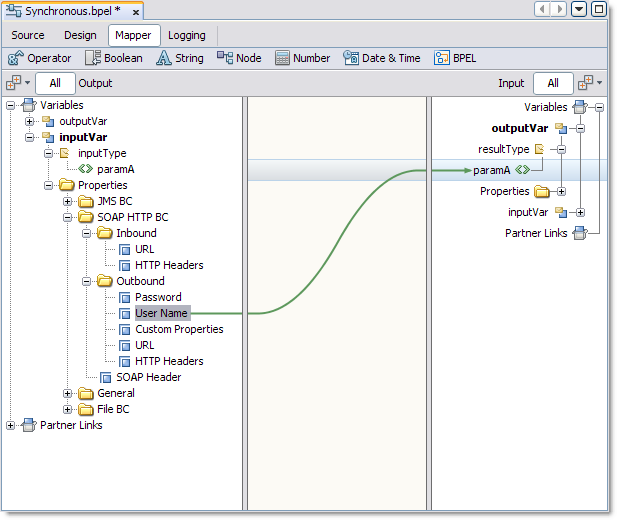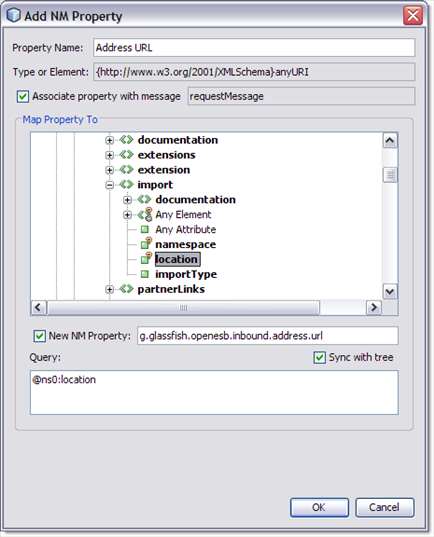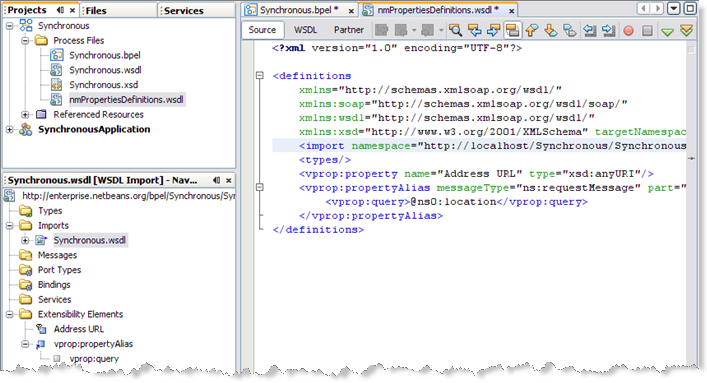| Skip Navigation Links | |
| Exit Print View | |

|
Oracle Java CAPS HTTP Binding Component User's Guide Java CAPS Documentation |
| Skip Navigation Links | |
| Exit Print View | |

|
Oracle Java CAPS HTTP Binding Component User's Guide Java CAPS Documentation |
Using the HTTP Binding Component
About the HTTP Binding Component
HTTP/SOAP Binding Architecture
HTTP Binding Component Features
HTTP Binding Component Example Scenario
SOAP 1.1 WSDL Extensibility Elements
SOAP 1.1 header and headerfault Elements
SOAP 1.2 WSDL Extensibility Elements
SOAP 1.2 header and headerfault Elements
HTTP WSDL Extensibility Elements
Configuring the HTTP Binding Component for HTTP Get Interactions
Using the HTTP Binding Component with the HTTP POST Method
Configuring the HTTP Binding Component for HTTP Get Interactions
HTTP POST Treatment of http:urlEncoded and http:urlReplacement
HTTP Binding Component Runtime Properties
HTTP Binding Component Client Endpoint Properties
Accessing the HTTP Binding Component Client Endpoint Properties
HTTP BC Client Endpoint Configuration Properties
Using Normalized Message Properties to Propagate Binding Context Information
Using Normalized Message Properties in a BPEL Process
Using Predefined Normalized Message Properties in a BPEL Process
To use predefined normalized message properties in a BPEL process
Adding Additional Normalized Message Properties to a BPEL Process
To add a Normalized Message Property Shortcut to a BPEL process
To edit an NM Property Shortcut
To delete an NM Property Shortcut
To add a Normalized Message Property to a BPEL process
BPEL Code Generation Using NM Properties
SOAP HTTP Binding Component Specific Normalized Message Properties
Quality of Service (QOS) Features
Configuring the Quality of Service Properties
Message Throttling: Configuring and Using
Configuring the HTTP Binding Component Endpoint for Throttling
Redelivery: Configuring and Using
Using the Tango Web Service Features with the HTTP Binding Component
Configuring Reliable Message Delivery
Installing the Synchronous BPEL Process sample
Configuring Web Services for a Project from the CASA Editor
Configuring the Tango Web Services Attributes exposed by the HTTP Binding Component
Accessing the Tango (WSIT) Web Service Attribute Configuration
Accessing the WS-Policy Attachment Editor for a Specific Endpoint
Server Configuration--Web Service Attributes
Client Configuration -- Web Service Attributes
HTTP Binding Component Security
Using Basic Authentication with the HTTP Binding Component
Basic Authentication Supported Features
Authentication Mechanisms for Consumer Endpoints
WssTokenCompare Username/Password Authentication
Using the Access Manager for Authentication and Authorization
Installing the Access Manager Add-on
Installing Access Manager with Java Application Platform SDK
Configure the HTTP Binding Component to use Access Manager
Using the OpenSSO Web Services Security (WSS) Agent for Authentication and Authorization
Install OpenSSO Enterprise Server
Configure the HTTP Binding Component to use OpenSSO Web Service Security
Using the GlassFish Realm Security to Authenticate the HTTP Client Credentials
Configuring Security Mechanisms
Username Authentication with Symmetric Key
Message Authentication over SSL
SAML Sender Vouches with Certificates
STS Issued Token with Service Certificate
Using Application Variables to Define Name/Value Pairs
Using Application Variables for password protection
Creating a password Application Variable
Using Application Configuration to Configure Connectivity Parameters
To apply a named Config Extension to the Application Configuration
Clustering Support for the HTTP Binding Component
Configuring the HTTP Binding Component for Clustering
Understanding the ${HttpDefaultPort} Token
Validating HTTP Extensibility Elements from the WSDL Editor
Adding a SOAP Template to a WSDL Document
Adding an HTTP Template to a WSDL Document
Web Service Client Calling an Operation Using HTTP Basic Authentication
Web Service Implementing an Operation Protected by HTTP Basic Authentication
Web Service Client Calling an Operation Using SSL Authentication
Web Service Implements an Operation Protected by SSL Authentication
Normalized Message properties are commonly used to specify metadata that is associated with message content. javax.jbi.security.subject and javax.jbi.message.protocol.type are two examples of standard normalized Message properties defined in the JBI Specification.
Normalized Message properties are used to provide additional capabilities in Open ESB, such as:
Getting and Setting transport context properties. For example, HTTP headers in the incoming HTTP request, or file names read by the File Binding Component
Getting and Setting protocol specific headers or context properties (SOAP headers)
Getting and Setting additional message metadata. For example. a unique message identifier, or an endpoint name associated with a message
Dynamic configurations. For example, to dynamically overwrite the statically configured destination file name at runtime
Some of the use cases mentioned above require protocol/binding specific properties, typically used by a particular binding component. Other properties are considered common or general purpose properties that all participating JBI components make use of, for example, the message ID property, which can be utilized to uniquely identify or track a given message in the integration.
The Normalized Message properties are accessed from the BPEL Designer Mapper view. When you expand a variable's Properties folder it exposes the variable's predefined NM properties, as well as the regular BPEL specific WSDL properties used in correlation sets, assigns, and to build expressions . If the specific NM property you need is not currently listed, additional NM properties can be added.
Predefined Normalized Message properties are ready for use, from a variable's Properties file.
The Properties file contains the predefined Normalized Message (NM) properties.

If the specific NM Property you want is not listed, you can add additional NM properties.
There are two options available when adding NM Properties:
Add NM Property Shortcut: This option typically supports simple type properties, in that it does not grant access to some data within the NM Property.
Add NM Property: This option provides access to data within the NM property used to build expressions.
The Add NM Property Shortcut dialog box appears.

The new NM property is added to the Mapper tree under the variables Properties directory. The property can now be used in assigns and to build expressions.
The Add NM Property Shortcut dialog box appears.
The NM Property Shortcut is deleted.
The Add NM Property dialog box appears.
A check mark indicates that the new NM property is associated with all variables of the specified message type. For example, in the image below, the new NM property will be associated with the requestMessage type.
Unchecked indicates that the new NM property is associated with all variables of any message type.
When you select a node within the property tree the Type or Element and Query fields are populated automatically. Valid endpoint nodes are displayed in bold.


The new NM property can now be used in assigns and to build expressions.
The property is deleted.
Data copied from an NM property or an NM property shortcut generates code that is similar to the following:
<from variable="inputVar" sxnmp:nmProperty="org.glassfish.openesb.file .outbound.dcom.username"/>
Data copied from WSDL properties based on NM property generates code that is similar to the following:
<from variable="inputVar" property="ns3:DemoNMProperty"/>
When properties and NM properties are used to build an expression, code similar to the following code is generated:
<from>concat(bpws:getVariableProperty('inputVar', 'ns3:DemoNMProperty'),
sxnmp:getVariableNMProperty('inputVar','org.glassfish.openesb.file.outbound.dcom.
username'))</from>
An NM property used in a condition generates code that is similar to the following:
<condition>sxnmp:getVariableNMProperty('inputVar', 'my.nmProperty.boolean')</condition>
Normalized Message properties are either General, available to all participating JBI components, or protocol/binding specific, used by a particular binding component.
Table 19 General Normalized Message Properties
|
The following properties are specific to the HTTP (SOAP) Binding Component.
Table 20 SOAP HTTP Binding Component NM Properties
|
Note - The org.glassfish.openesb.custom.properties property is designed to allow custom data to be set on the HTTP/SOAP binding message context. The custom properties on the binding message context can then be made available in the security CallbackHandlers. For example, you can allow custom SAML assertion headers to be set in the SAML CallbackHandler based on the user credentials (application data) set on the binding message context.